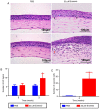A murine model of dry eye induced by topical administration of erlotinib eye drops
- PMID: 29286080
- PMCID: PMC5819933
- DOI: 10.3892/ijmm.2017.3353
A murine model of dry eye induced by topical administration of erlotinib eye drops
Abstract
In the present study, the effects of erlotinib on mouse tear function and corneal epithelial tissue structure were investigated. Throughout the 3 weeks of treatment, no notable differences were observed in the body, eye or lacrimal gland weights of the control and experimental mice. However, in the experimental group, the tear volume and break‑up times of tear film were significantly lower following treatment with erlotinib compared with the control group. Corneal fluorescein staining in the experimental group revealed patchy staining, and the Lissamine green staining and inflammatory index were significantly higher in the experimental group at 3 weeks than in the control group. In the experimental group, the number of corneal epithelium layers increased significantly following treatment with erlotinib for 3 weeks and a significant increase in the number of vacuoles was observed compared with the control group. Treatment with erlotinib significantly increased the corneal epithelial cell apoptosis, and led to a significantly increased number of epithelial cell layers and increased keratin 10 expression. It also significantly reduced the number of conjunctival goblet cells. Transmission electron microscopy and scanning electron microscopy revealed that the corneal epithelial surface was irregular and there was a substantial reduction and partial loss of the microvilli in the experimental group. Mice treated with erlotinib also exhibited an increased protein expression of tumor necrosis factor‑α and decreased protein expression of phosphorylated‑epidermal growth factor receptor in the corneal epithelial cells. The topical application of erlotinib eye drops was revealed to induce dry eyes in mice. This is a novel method of developing a model of dry eyes in mice.
Figures






References
-
- Zhou C, Wu YL, Chen G, Feng J, Liu XQ, Wang C, Zhang S, Wang J, Zhou S, Ren S, et al. Erlotinib versus chemotherapy as first-line treatment for patients with advanced EGFR mutation-positive non-small-cell lung cancer (OPTIMAL, CTONG-0802): A multicentre, open-label, randomised, phase 3 study. Lancet Oncol. 2011;12:735–742. doi: 10.1016/S1470-2045(11)70184-X. - DOI - PubMed
MeSH terms
Substances
LinkOut - more resources
Full Text Sources
Other Literature Sources
Research Materials

